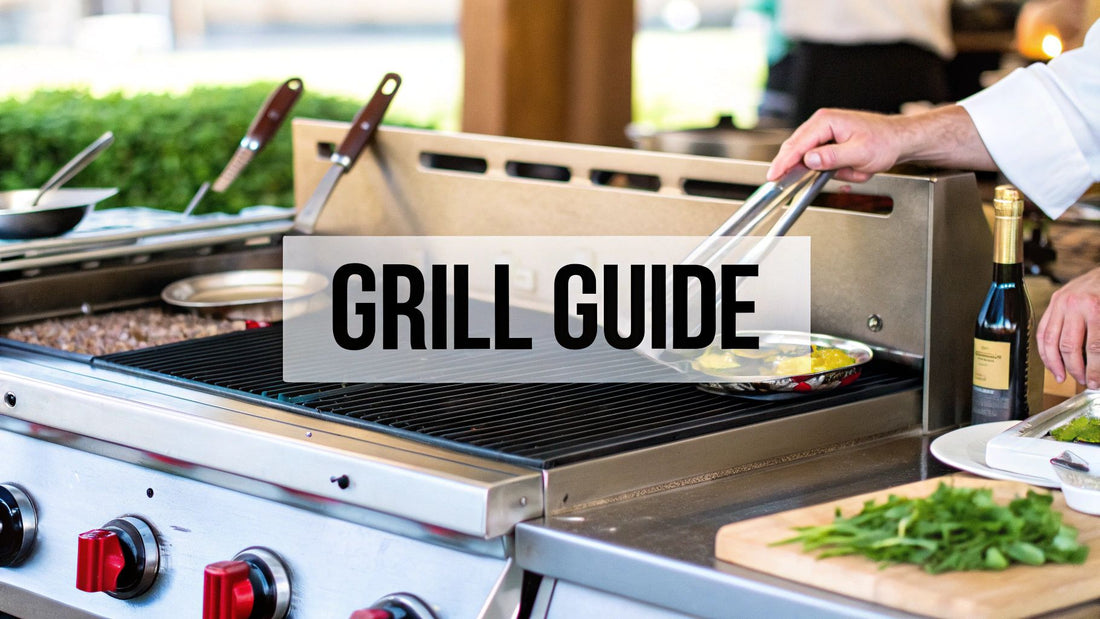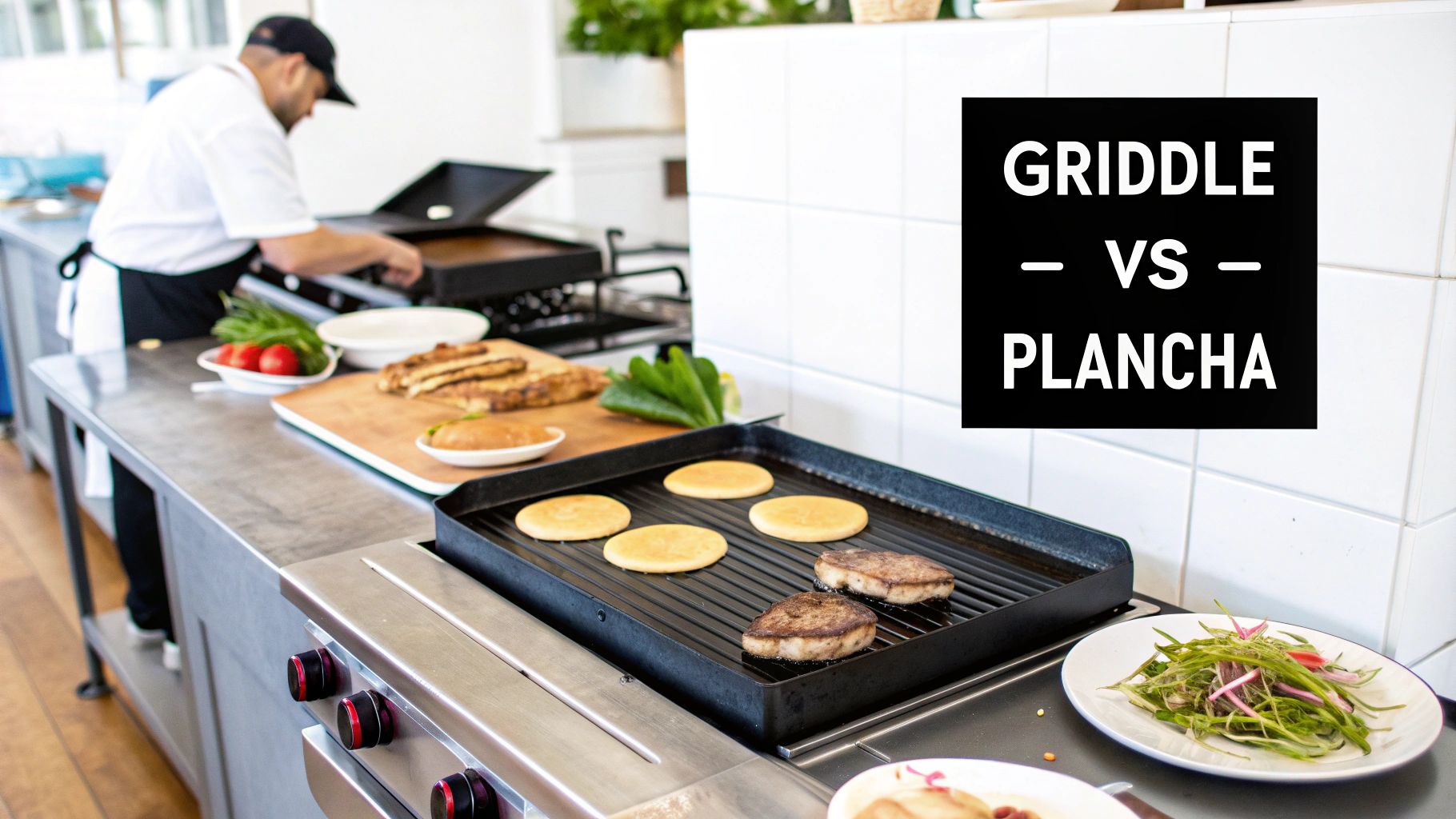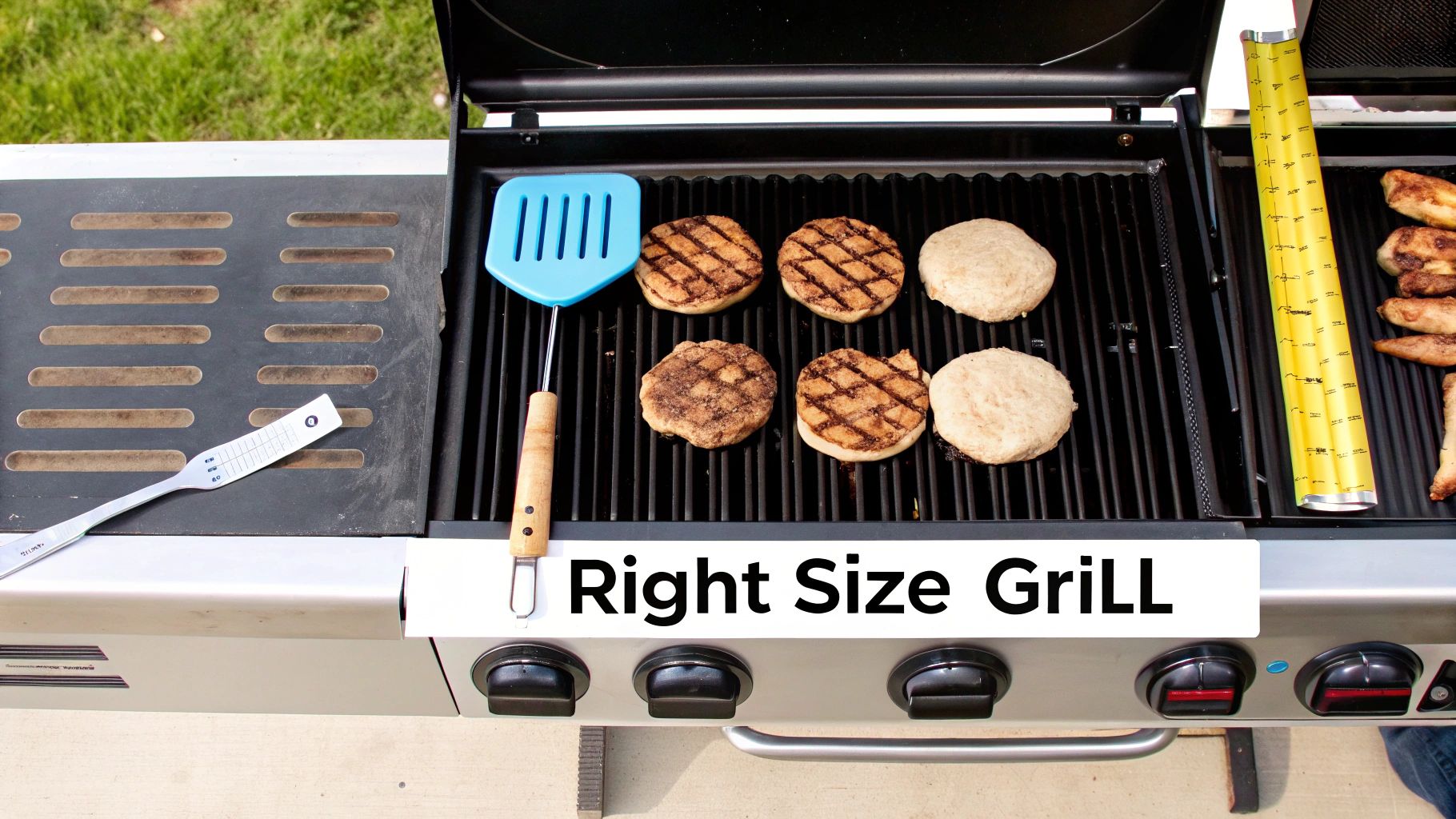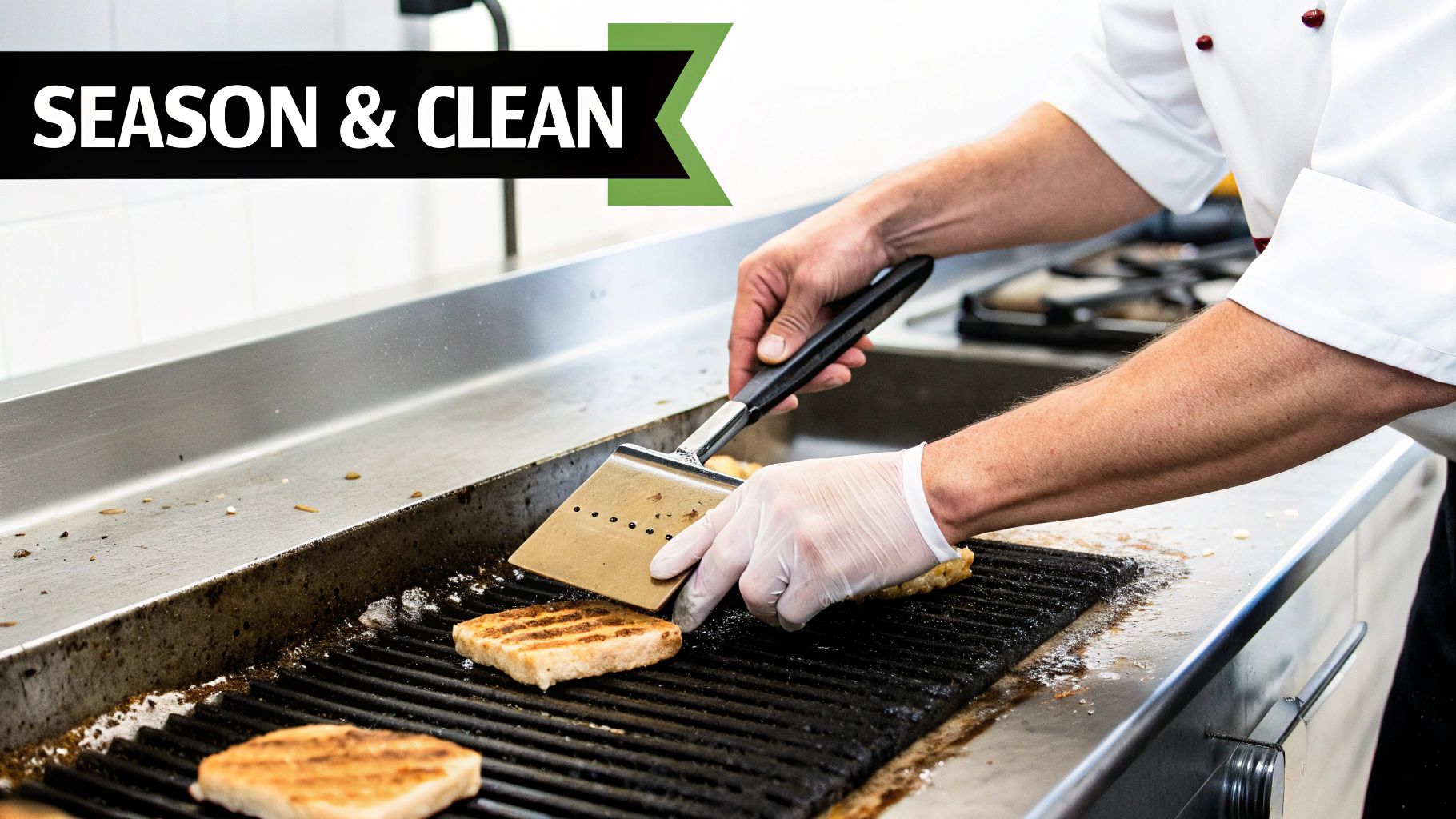
Choosing a flat top grill for restaurant: A practical guide
Share
Picking the right flat top grill for your restaurant isn't just about buying a piece of equipment. It's a major decision that ripples through your entire kitchen, affecting your workflow, what you can put on your menu, and even your bottom line. Think of it as the heart of your cook line—the workhorse that has to perform flawlessly from the first breakfast ticket to the last dinner plate.
This guide is designed to cut through the noise and give you clear, practical advice to help you land the perfect flat top for your kitchen's unique needs. Stay informed about the latest industry trends and find the best equipment to elevate your culinary operations.
Why Your Grill Choice Is a Strategic Investment
When you're looking at a flat top grill for restaurant use, you're making a strategic investment that shapes your day-to-day reality. The right grill helps you crush the dinner rush by keeping ticket times down, guarantees that every burger is cooked just right, and even keeps your utility bills in check. It’s where your ingredients are transformed into the dishes your customers love.
Here’s a quick rundown of what’s at stake:
- Speed and Efficiency: A grill that’s the right size and recovers heat quickly is your best friend during a slammed service. No more waiting for the surface to get back to temp.
- Menu Versatility: What do you want to cook? A high-heat plancha is perfect for getting that perfect sear on a steak, while a standard griddle is your go-to for fluffy pancakes. Your grill defines your capabilities.
- Operational Costs: Gas or electric? The answer, along with the grill's overall efficiency, will show up on your utility bills every single month.
- Food Quality: Consistent, reliable temperature control is the secret to consistency. It ensures every dish that leaves the kitchen is up to your standards, every single time.
Making the Right Decision
To make this big decision a little easier, this decision tree breaks down the key things you need to think about: how much food you're cooking, how much space you've got, and what kind of fuel source makes the most sense for you.
As you can see, your restaurant’s specific needs will point you directly to the best grill for the job. It’s no surprise that this kind of versatile gear is in high demand. The global market for commercial griddles and flat top grills hit an estimated USD 7.8 billion in 2023.
Looking ahead, experts project that the market will grow at a rate of 6.5% every year from 2025 to 2033. That’s a clear sign that more and more kitchens are realizing just how essential these cooktops are. Staying informed on these trends helps you make smarter purchasing decisions.
One last thing to keep in mind: when you're getting ready to install your new grill—especially if it's an electric model—do yourself a favor and bring in a qualified commercial electrical contractor. They'll make sure everything is hooked up correctly and safely, which is one less thing for you to worry about.
Decoding Commercial Griddle and Plancha Types
Walk into any busy kitchen, and you'll likely find a flat top grill, but not all of them are created equal. It’s easy to look at a flat piece of steel and assume it’s all the same, but the subtle differences between a standard griddle, a plancha, and a teppanyaki grill are huge. Knowing what sets them apart is the first step in choosing the right tool for your menu and staying ahead of industry trends.
Think of a standard griddle as the all-purpose workhorse of the kitchen, especially in a classic American diner. Its heating elements are often deliberately spaced out to create different temperature zones on the same surface. This is a game-changer for a busy line, letting a cook gently warm tortillas on one side while getting a hard sear on burgers just a few inches away.
The Power of Planchas
A plancha, on the other hand, is built for pure, brute-force heat. This Spanish cooking surface is all about getting incredibly hot and staying that way across the entire plate. We’re talking about intense, direct heat that delivers an amazing Maillard reaction—that perfect, crusty, flavorful sear on a steak or a delicate scallop—in a matter of seconds.
A plancha's real magic is in its speed and precision. The uniform, ultra-hot surface gives you an unmatched sear that locks in juices and flavor almost instantly. If your kitchen lives and dies by that perfect crust, a plancha is a must-have.
The Theater of Teppanyaki
Then there’s the teppanyaki grill. Functionally, it's pretty close to a standard griddle, but its real purpose is performance. These are designed to be front-and-center, where chefs can put on a show for their guests. It’s less about back-of-house utility and more about the sizzle and spectacle, which is why it’s the centerpiece of any Japanese steakhouse or hibachi restaurant.
So, which one is right for you? It really boils down to your menu and style of service:
- Standard Griddle: The go-to for diners, cafes, and any spot juggling a diverse menu that needs multiple cooking temperatures at once.
- Plancha: Perfect for high-end kitchens, steakhouses, and seafood spots where a fast, hard sear is everything.
- Teppanyaki Grill: The clear choice for restaurants built around "eatertainment," where the cooking is part of the guest experience.
This variety shows just how specialized the equipment world has become. The overall commercial griddle market is already huge—estimated at USD 2.06 billion in 2024 and expected to hit USD 2.4 billion by 2030—and it’s a space where tiny differences in design matter. You can dig deeper into these commercial griddle market trends to see for yourself. By understanding these nuances, you can pick a flat top grill for your restaurant that doesn't just fit the line, but actually makes your food better.
Choosing Your Fuel Source: Gas vs. Electric
One of the biggest decisions you'll make for your cook line is whether to go with a gas or electric flat top grill. This choice goes way beyond just hooking up a utility line; it fundamentally shapes how your kitchen performs, especially when you're in the weeds during a dinner rush. It’s all about power, precision, and what your specific menu demands.

Think of a gas grill as pure, unadulterated power. It fires up fast and lets you make temperature changes on the fly, which is exactly what a high-volume kitchen needs. If you’re running a burger joint that’s slammed from noon to two, that instant heat recovery is a lifesaver. Every time you drop a dozen cold patties, a high-BTU gas unit fights back, getting back to searing temperature almost immediately. This means consistent cooking and faster ticket times. For kitchens that live and die by speed, a https://encoreseattle.com/blogs/seattle-restaurant-equipment/commercial-flat-top-grill-propane is often the go-to workhorse.
The Case for Electric Precision
Electric flat tops, on the other hand, are the masters of control and consistency. They operate more like a finely-tuned oven, spreading heat incredibly evenly across the entire surface. This level of precision is a game-changer for delicate items like pancakes, crêpes, or perfectly cooked sunny-side-up eggs.
With an electric model, you can say goodbye to those frustrating hot and cold spots. You get a cooking surface you can trust, order after order. The newer induction models take this even further, boasting faster preheating and impressive energy savings—a key industry trend for cost-conscious owners.
The real difference comes down to this: Gas delivers raw, responsive power for high-volume searing. Electric offers unwavering temperature control and consistency for delicate foods and a more comfortable kitchen.
Operational and Maintenance Factors
Beyond how they cook, your choice affects your kitchen's environment and daily maintenance. Gas grills pump a lot more ambient heat into your kitchen, which can make things uncomfortable for your staff and put a bigger strain on your ventilation system.
Electric units, especially induction, are far more efficient. They transfer heat directly into the cooking plate, not into the air around it. This means a cooler kitchen and, often, a lower energy bill. When you're looking at electric models, it pays to know what's under the hood. Understanding the common issues with electric stove elements can give you a heads-up on future maintenance and help you make a smarter long-term purchase.
Ultimately, the best flat top grill for a restaurant comes down to your menu and your workflow.
- Choose Gas if: You’re slinging burgers, steaks, and other seared proteins. You need that quick recovery to keep up with high-volume rushes.
- Choose Electric if: Your menu relies on delicate items needing precise heat. Energy efficiency and a cooler, more comfortable kitchen are also big priorities for you.
By thinking through these practical scenarios, you can pick a fuel source that doesn’t just work in your kitchen—it makes your kitchen work better.
Sizing Your Grill for Maximum Menu Output
Picking the right size flat top grill isn't just about finding an open spot on the cook line. It's about matching your equipment to your menu and, most importantly, to the chaos of your busiest service. Get this wrong, and you've created an instant bottleneck. A grill that’s too small will sink your Saturday night service with painfully long ticket times. Go too big, and you're just burning cash on wasted energy and space.
The secret is to stop thinking about physical dimensions and start thinking about production capacity. Before you even browse for models, picture your kitchen during its peak rush. How many burgers, pancakes, or steaks are you firing at the same time? That number is what truly dictates the cooking surface you need.
A grill's width is the go-to measurement, and each size up represents a totally different scale of operation.
Matching Grill Size to Your Restaurant
The type of restaurant you run has everything to do with the size of the grill you need. More covers mean you need more cooking real estate to keep the tickets moving.
To help you visualize the right fit, here's a quick guide matching common restaurant types with the grill sizes that can keep up with their demand.
Grill Size and Restaurant Type Match-Up
This table breaks down typical scenarios to help you estimate the right grill width for your kitchen.
| Restaurant Type | Peak Hour Covers | Recommended Grill Width (Inches) | Primary Menu Items |
|---|---|---|---|
| Small Café / Food Truck | 15-30 | 24 | Eggs, bacon, breakfast sandwiches, single-patty burgers |
| Neighborhood Diner | 40-60 | 36-48 | Full breakfast, burgers, melts, Philly cheesesteaks |
| Mid-Sized Casual Dining | 60-100 | 48-60 | Varied menu: chicken, fish, multiple burger types, sautéed veg |
| High-Volume Steakhouse | 100+ | 72+ | Steaks, chops, seafood, high-volume side dishes |
Matching the grill to your busiest hour, not your average Tuesday, is the only way to ensure you're prepared for the rush.
-
Small Café or Food Truck (24-inch Grill): Perfect for a tight space or a focused menu. This size is a champ for a one-person line cranking out eggs and bacon, but it'll get crushed trying to handle a diverse lunch rush.
-
Bustling Diner or Mid-Sized Restaurant (48-inch Grill): For many, the 48-inch model is the goldilocks size—just right. It offers enough room to juggle multiple orders and a varied menu without being monstrous. To see what a workhorse like this offers, check out the specs on an Atosa 48-inch griddle.
-
High-Volume Steakhouse or Institution (72-inch+ Grill): When you absolutely cannot fall behind, a 72-inch (or larger) grill is what you need. These beasts are built for kitchens that serve hundreds of people in a single service, giving chefs the massive surface area required to execute a large menu flawlessly.
Your grill size should be determined by your busiest hour on your busiest day. Sizing for an average Tuesday afternoon is a recipe for a disastrous Saturday night service.
Bigger grills also unlock a massive advantage: cooking zones. Models with multiple thermostats let you transform a single 72-inch surface into three different stations. You can have one section ripping hot for searing steaks, a middle zone for gently sautéing vegetables, and a third set to low for toasting buns or holding finished food. This isn't just efficient; it's a smarter way to work.
Finally, think about where it’s going to live. The grill needs to be the heart of your cook line, positioned to minimize the steps your team takes. Good placement creates a faster, more ergonomic workflow and ensures you’ve got the proper ventilation and safety clearances covered.
Essential Features and Build Quality That Matter
A flat top's lifespan is written in its steel. Once you've figured out the size and fuel type, the real decision comes down to build quality. This is what separates a reliable workhorse that will anchor your line for years from a piece of equipment that's going to fail you during a Saturday night rush.

The single most important component is the grill plate itself. The thickness and material will make or break your grill's performance, dictating how well it holds heat and how fast it recovers when you're slammed.
Think of a thick, 1-inch steel plate like a well-seasoned cast-iron skillet. It holds a massive amount of heat, so when you drop a dozen cold burger patties on it, the surface temperature doesn't crash. A thinner plate might heat up faster, but it also loses that energy in a flash, leading to longer cook times and inconsistent sears.
Understanding Grill Plate Materials
The surface you cook on has a huge impact on your day-to-day. It determines your cleaning routine, how flavors transfer (or don't), and your upfront cost.
- Steel Plate: This is the industry standard for a reason. It's tough, affordable, and a champion at retaining heat. You'll need to season it properly to get that non-stick surface, and it requires some muscle to keep carbon from building up, but its sheer resilience makes it a kitchen staple.
- Chrome Plate: If your kitchen is open to the dining room, you've probably seen these. The mirror-like finish is less porous than steel, which means less flavor transfer between items like fish and pancakes. It's also a breeze to clean. The trade-off? It's more expensive and you have to use specific non-abrasive tools to avoid scratching that beautiful, delicate surface.
- Composite Plate: These are the high-tech option, engineered for incredibly fast heat transfer and recovery. They’re designed for energy efficiency and perfectly even cooking, hitting a sweet spot between the performance of thick steel and the lower maintenance of chrome.
Beyond the Cooking Surface
Don't just stare at the cooking plate. The little details are what you'll either love or hate during service. Look for durable thermostats that give you precise temperature control you can trust. A well-designed grease management system is also a must—a big, easy-to-remove grease trap will save your crew a ton of headaches at closing.
Also, check for practical features like tall backsplashes and side splashes. They might seem minor, but they do a fantastic job of containing grease splatter, which keeps the rest of your line safer and cleaner. These are the hallmarks of a grill designed by people who've actually worked in a kitchen.
This focus on high-performance features is driving the market. In fact, global sales for restaurant griddles hit USD 458.2 million in 2025 and are expected to nearly double by 2035. You can see more details in this report on restaurant griddle market growth trends.
Keeping Your Grill in Top Shape for the Long Haul
Your flat top grill is a serious investment. How it performs a year from now depends entirely on how you treat it today. A solid maintenance routine isn't just a suggestion—it's essential for protecting your kitchen's workhorse, guaranteeing food safety, and making sure you get your money's worth. Skip it, and you're asking for bad heat transfer, flavor contamination between dishes, and a much shorter lifespan for your equipment.
The very first thing you need to do with a new steel grill is season it. This is where you create that slick, non-stick surface by applying a thin layer of high-smoke-point oil and heating it up. It’s the exact same idea as breaking in a new cast-iron pan at home. That little bit of effort up front will make every single service run smoother, with easier cooking and cleanup.
The Daily Cleaning Ritual
The goal of daily cleaning is to preserve that beautiful seasoned surface you worked to create, not to strip it bare. Using the wrong tools or harsh chemicals can undo all that initial work in an instant. All you really need is a simple, consistent process to keep your flat top grill for restaurant kitchens in perfect working order.
Here’s what you should be doing at the end of every single shift:
- Let It Cool Down (A Bit): Let the grill cool to a manageable 300°F–350°F. Whatever you do, don't pour cold water on a piping hot grill—that's a surefire way to warp the metal plate.
- Scrape the Gunk: Grab a good griddle scraper and get all that leftover food residue and grease off the cooking surface.
- Break Out the Grill Brick: While it’s still warm, put a little oil on the surface and gently scrub with a griddle brick. Make sure you move with the grain of the metal. This little trick lifts away any stubborn, burnt-on bits without scratching the plate.
- Wipe and Re-Oil: Wipe everything down with a clean, damp cloth. To finish, apply a super light coat of cooking oil to protect the steel from rust and reinforce that non-stick layer.
This simple daily habit is the single best thing you can do for your grill. It prevents the carbon buildup that kills heat transfer, stops rust in its tracks, and ensures every dish starts on a clean, neutral surface.
Think of these steps as just one piece of a bigger puzzle. For a full rundown on how to protect all your kitchen equipment, check out our complete guide on commercial kitchen equipment maintenance. By making this routine part of your closing checklist, you’ll ensure your grill stays the reliable, high-performing heart of your kitchen for years to come.
Frequently Asked Questions About Restaurant Flat Top Grills

Pulling the trigger on a big equipment purchase always brings up a few last-minute questions. To help you feel completely confident in your investment, we've pulled together straight answers to the things we hear most often from chefs and owners about flat top grills.
How Much Should I Expect To Spend?
The price tag on a commercial flat top grill for restaurant use can really run the gamut. You might see smaller countertop models starting around $500, but a heavy-duty, high-volume floor model can easily climb past $10,000.
For most kitchens, the sweet spot for a durable, reliable unit that can handle the daily grind is somewhere in the $2,000 to $5,000 range. Don’t just look at the initial cost—think about long-term value, like energy efficiency and how well it's built. Be sure to look out for exclusive deals that can help you get more for your budget.
What Is the Difference Between a Griddle and a Plancha?
It all comes down to how they manage heat. A standard griddle usually has multiple heating elements, which can create intentional hot and cool zones on the surface. This is great when you need to cook different items at different temperatures simultaneously.
A plancha, on the other hand, is built for one thing: screaming hot, even heat across the entire plate. This makes it the champion for getting that perfect, high-temperature sear and a consistent crust on steaks, scallops, and other proteins.
A thicker grill plate—think 3/4-inch to 1-inch—is almost always a better investment. It holds onto heat like a champ, so the temperature doesn't plummet when you throw down a batch of cold food. That means faster recovery times and more consistent results during a chaotic dinner rush.
How Often Do I Need To Season My Steel Flat Top Grill?
After you've done that initial, heavy-duty seasoning, a quick, light re-seasoning at the end of every shift is all you need.
Once you’ve scraped and cleaned the grill, just wipe on a super-thin layer of a high-smoke-point oil while the surface is still warm. This daily ritual is the secret to keeping that non-stick surface slick, preventing rust, and making sure your grill is ready to rock for the next service.
Ready to find the perfect flat top grill for your kitchen? The team at Encore Seattle Restaurant Equipment has the hands-on expertise and the inventory to find the right fit for your menu and your budget. We help restaurant owners and chefs discover exclusive deals on the latest restaurant equipment and supplies. Explore our selection of new and used equipment today at https://encoreseattle.com and set your kitchen up for success.
